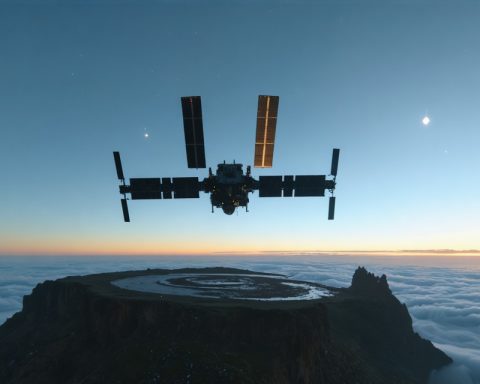- Residents of Canada’s east coast will experience a rare partial solar eclipse at sunrise, transforming the sky into a striking crescent sun display.
- In this cosmic alignment of Earth, the moon, and the sun, over 80% of the sun’s disc will be covered in locations like Atlantic Canada and eastern Quebec, with over 90% coverage along the Labrador coast and Baffin Island.
- Specialized equipment is necessary for safe viewing, as looking directly at the sun is hazardous.
- Major viewing times include 6:58 a.m. to 8:52 a.m. in St. John’s and an earlier start in Halifax around 7 a.m.
- The event offers a unique opportunity for photographers and sky watchers to capture the extraordinary beauty of a crescent sun at the ocean horizon.
- Astronomy enthusiasts and curious onlookers are encouraged to embrace the fleeting moment for its reminder of our universe’s dynamic beauty.
As dawn approaches on Saturday, residents of Canada’s east coast will witness an awe-inspiring transformation in the sky, turning the often tranquil sunrise into a dazzling celestial event. Instead of the familiar reddish glow, the sun will rise as a striking crescent, creating an unforgettable visual spectacle.
This rare event is a partial solar eclipse, following closely on the heels of the lunar eclipse that captivated North America earlier this month. It’s a cosmic dance where Earth, the moon, and the sun align in a picturesque celestial choreography, casting shadows and creating moments of wonder.
For early risers in locations like Atlantic Canada and eastern Quebec, this partial eclipse will cloak more than 80% of the sun’s disc. The Labrador coast and Baffin Island are treated to an even more dramatic view, with over 90% coverage. Those positioned further west, such as Ottawa, will glimpse a much subtler version, while Toronto may not catch the phenomenon at all.
Such celestial events come with their cautions. Staring directly at the sun is hazardous, and specialized equipment is necessary. Any leftover viewers from past eclipses should be inspected for damage, ensuring safe observation. The opportunity peaks with the sunrise itself, making it an easy moment to remember—but only if the skies are clear.
For St. John’s, the entire display is visible from 6:58 a.m. to 8:52 a.m., offering a generous window to those eager to witness this cosmic marvel. Halifax will find a slightly different timetable, with the sun morphing as early as 7 a.m. and reaching its fullest extent shortly after.
Enthusiasts like Tiffany Fields, an astronomy technician from Halifax, plan to seize this fleeting moment. Such devotion highlights the allure the cosmos holds for many, and why these events captivate audiences far and wide.
The mingling of atmospheric phenomena with the eclipse’s natural wonder provides a canvas for photographers and sky watchers, creating a unique opportunity to capture timeless images as the crescent sun dances over ocean horizons.
The key takeaway for observers is simple yet profound: seize the moment. These events remind us of the dynamic beauty of our universe, visible right from our own backyards. Whether you’re an avid stargazer or a curious observer, witnessing a new day dawn beneath a crescent sun is a scene not soon forgotten.
Don’t Miss This Celestial Spectacle: How to Witness the Partial Solar Eclipse Safely
As residents of Canada’s east coast prepare for a stunning celestial display, understanding the intricacies of a partial solar eclipse can enhance the viewing experience. This rare alignment of the Earth, moon, and sun offers a breathtaking spectacle, but requires proper preparation for safe observation.
Understanding Solar Eclipses
A partial solar eclipse occurs when the moon passes between the Earth and the sun, but only blocks a portion of the sun’s light. Unlike a total solar eclipse, where the sun is completely obscured, the partial eclipse offers a stunning crescent effect. This event casts dynamic shadows and creates dramatic visual effects. The last significant solar eclipse captured the fascination of millions around the world.
Safety First: Viewing Tips
How-To: Safely Observe the Eclipse
1. Use Certified Eclipse Glasses: Ensure you have proper eye protection. Regular sunglasses are not safe. Purchase glasses that comply with the ISO 12312-2 safety standard.
2. Inspect Equipment: Check that any leftover eclipse viewers from past events are undamaged before use.
3. Alternative Viewing Methods: If you don’t have eclipse glasses, consider using a pinhole projector or watching the eclipse through a telescope equipped with a proper solar filter.
Real-World Use Cases
Many schools and science clubs use solar eclipses as educational opportunities to engage students in astronomy. Hosting watch parties with experts explaining the science behind eclipses can make the event both fun and informative.
Market Forecasts & Industry Trends
The interest in astronomical events like solar eclipses has led to an increase in consumer demand for related products, including specialized viewing equipment and photography gear, according to market research firms. There’s a growing trend towards experiential learning, with more educational institutions incorporating celestial events into their curricula.
Best Viewing Locations
The east coast of Canada, including areas such as Atlantic Canada and eastern Quebec, provides some of the best viewing opportunities. However, optimal views also depend on weather conditions. Check local forecasts ahead of time to ensure clear skies.
Controversies & Limitations
There is an ongoing debate within the scientific community about the best ways to engage the public with astronomical events while ensuring safety. The issue of unsafe eclipse glasses has been a problem in the past, highlighting the necessity for public awareness around proper viewing methods.
Features, Specs & Pricing of Eclipse Glasses
Quality eclipse glasses are relatively inexpensive, costing anywhere from $1 to $20. They feature special solar filters that reduce brightness and protect eyes from harmful solar radiation. Always verify the authenticity of the glasses’ certification to ensure safety.
Pros & Cons Overview
Pros:
– Unique and awe-inspiring experience.
– Encourages educational exploration of astronomy.
– Chance to capture unique photographs.
Cons:
– Risk of eye damage if viewed improperly.
– Weather-dependent visibility.
– Limited duration and visibility window.
Conclusion: Actionable Tips
– Plan Ahead: Check the eclipse schedule and weather forecasts for your area.
– Educate: Familiarize yourself with safe viewing practices to protect your eyes.
– Engage: Join local astronomy groups or online forums for additional insights and shared viewing experiences.
For those who find themselves inspired by the impending celestial event, organizations like NASA often offer online resources and live streams for deeper understanding and virtual participation.
This is a golden opportunity to witness the splendor of nature’s cosmic dance, blending science with the beauty of the natural world. Seize the moment and let the wonder of the universe leave you with a lasting impression.











